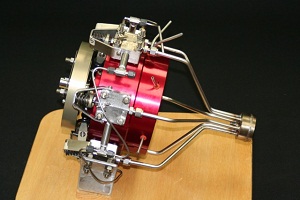Cyclone Power steaming up solar with new engine
 Solar engines aren’t new. Crookes radiometers have been around since the late 1800s. But the technology being used in Cyclone Power Technologies’ new Solar I engine design brings an entirely new type of engine, called a Schoell Cycle engine, into the game.
Solar engines aren’t new. Crookes radiometers have been around since the late 1800s. But the technology being used in Cyclone Power Technologies’ new Solar I engine design brings an entirely new type of engine, called a Schoell Cycle engine, into the game.
The company has developed and delivered plans for a five-horsepower, 3-kilowatt engine that works at 34 percent thermal efficiency to Spanish company Renolavia Energy SA.
“This is a small engine, a very compact five-horsepower engine,” said Cyclone President Christopher Nelson. “It’s designed for a parabolic dish that’s about 16 feet in diameter.”
The engine is a heat-regenerative, reciprocating steam engine that weighs 30 pounds.
The engine’s unique engine design superheats water into steam, which turns pistons on a drive shaft that converts the energy into the power that drives the electric generation. It runs at about 1,800 revolutions per minute, at about 1,000 degrees Fahrenheit at 1,000-psi, according to Nelson.
The device isn’t intended for residential solar.
“It’s meant for industrial purposes where you’d have a farm of several thousand engines,” Nelson said.
It’s an application similar to the Stirling engine-based concentrated solar generators like SunCatchers, which have run into some problems in terms of commercial deployment.
Still, the Cyclone engine promises higher efficiency than Stirling engines, which operate at a peak efficiency of around 20 percent, according to Nelson.
“What really makes this engine better than its competition is how small, light and efficient it is,” he said. “It’s about one-quarter the weight and size of a Stirling engine, which is important when you’re considering the structural support for these dishes. Having a light, small engine is big cost advantage.”
At this point the company’s developed prototypes of the device and has delivered the designs to Renolavia under a licensing agreement. It will start building the next generation of the engines next year, according to Nelson.
“We haven’t worked on the integration of the solar thermal collector yet. The next step going to beta would be to integrate it with a collector and start field testing,” he said.



